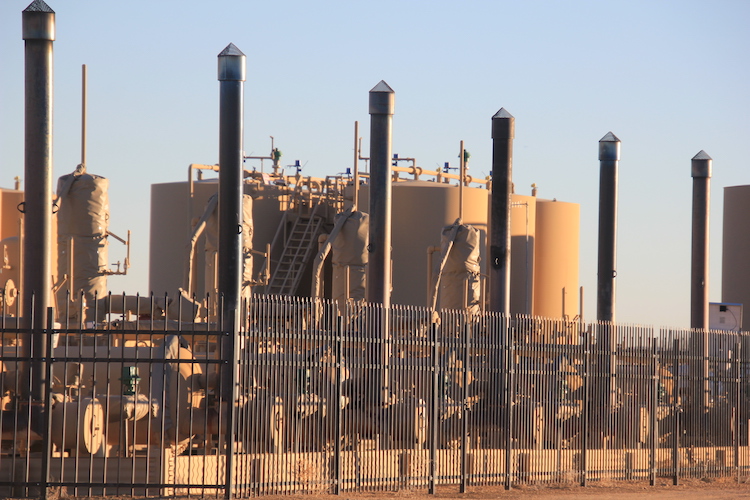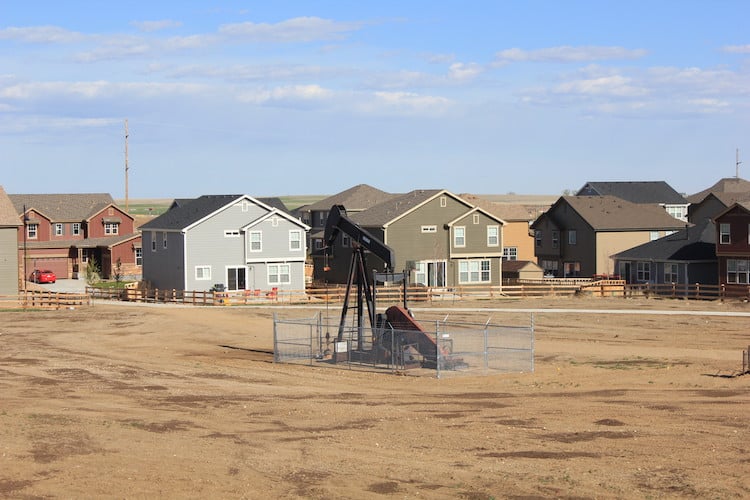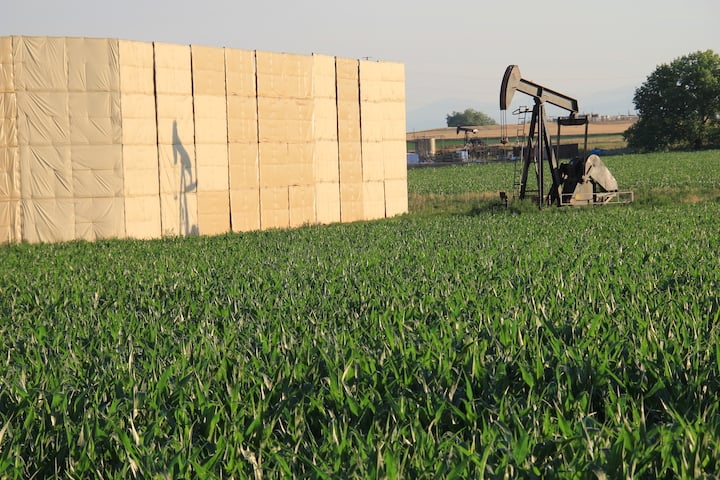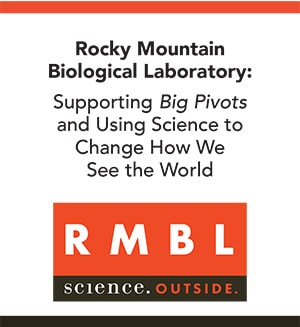Greater efforts to contain emissions among regulations resulting from 2019 law
by Allen Best
Regulations adopted by the Colorado Oil and Gas Conservation Commission in November have created a new playing field for the oil and gas industry.
Extraction of oil and gas now plays second fiddle to protecting public safety, health, welfare, and the environment.
The new rules triggered by a 2019 law, SB-181, reversed this order, detaching the commission from its long-standing statutory mission of fostering extraction. Now, it must regulate.
The law also replaced a part-time, 9-member commission of which 3 members were required to be from the oil and gas industry with a full-time 5-member commission, of which only 1 can be from the industry.
But back to the regulations adopted in November. What will they mean in practice?
Setbacks have received the most attention. Drilling sites must be a minimum of 2,000 feet from homes, schools, and childcare facilities, although some exemptions can be had, such as if homeowners say they’re just fine with closer proximity.
This means that instead of a buffer of approximately one city block, the minimum buffer must now be four city blocks.
Michael Freeman, an attorney with Earthjustice, a non-profit environmental law firm, said on a recent webinar that the recasting was informed by the testimony commissioners heard during the two or three months of hearings. Many testified to the growing body of literature detailing the public health impacts of oil and gas development and the risk of proximity to drilling sites.
Among the most significant evidence was a 2019 study by the Colorado Department of Public Health & Environment, he said, but many ordinary people also testified about what it was like to live next to a well pad with the resulting noise and many other impacts.
This evidence, said Freeman, was “very compelling and, frankly, difficult for the commission to ignore.”
This is from the Jan. 28, 2021, issue of Big Pivots, an e-magazine tracking the energy transition in Colorado and beyond. Subscribe at bigpivots.com
Protections were also extended to reduce impacts to wildlife in its many and various forms. Heeding the recommendation of Western Resource Advocates, the commission adopted rules that require consultation with Colorado Parks and Wildlife about impacts to species in the state’s listed threatened and endangered species. A stakeholder group is to be established to consider setbacks for all Colorado waters.
The commission also established and expanded “no occupancy” buffers for certain streams containing native and sport fish and other species, including boreal toads.
This new attention to wildlife comes in the framework of a broader perspective, both in spatial considerations and in cumulative impacts.
“The commissioners recognized landscape-level planning as the best approach, and avoidance (not ‘minimizing’ or ‘mitigation’) as the best and most protective policy,” says Mike Chiropolos, an attorney in Boulder who represents various parties in the Wildlife and Biological Resources Coalition.
“The Biological Resources Working Group will convene in 2021 to discuss defining and protecting those resources, including the use of Colorado Natural Heritage Program mapping and expertise to contribute to informed, science-based protective decisions,” Chiropolos wrote in an e-mail.

Extraction infrastructure in Weld County, east of Erie. Photo/Allen Best
“The prohibition of routine venting and flaring makes Colorado a national leader on this issue,” says Freeman. Colorado follows only Alaska in these tightened regulations.
Routine flaring is the practice of regularly burning excess gas, mostly methane, in oil and gas production and processing. It’s been done as long as oil drilling has occurred. This is a major source of greenhouse gas emissions.
Venting is releasing excess gas—methane—without burning it. Methane has far more power to trap heat as compared to carbon dioxide. Methane, however, breaks down after 12 years, whereas carbon dioxide can remain in the atmosphere for hundreds of years.
Sightline Institute explains that scientists therefore use an equivalence called global warming potential. It’s a way of trying to create a yardstick for measuring the heat-trapping potential of the two gases given that they have such different lifetimes. Over a 20-year span, methane has 86 times the heat-trapping property of carbon dioxide. according to the Intergovernmental Panel on Climate Change.
Colorado in 2014 adopted nationally precedent-setting measures designed to reduce leaks and accidental releases that were then considered the most advanced in the country. Those regulations set new thresholds for leaks, required more frequent inspections, and committed operators to more rapid Leak Detection and Repair (LDAR), as the Rocky Mountain Institute explained in a blog posted Nov. 25,
Non-routine, emergency flaring will continue, but these practices less concern RMI as long as they involve small flared gas volumes that are intermittent and occur in short durations.
In several fields in Colorado, natural gas is a byproduct of the extraction of oil. The new regulations will force oil and gas operators to figure out a way to capture natural gas released in conjunction with oil drilling, instead of routine venting or flaring. This regulation applies to tanks, controllers, and shut-in wells,
Flaring will still be allowed at new wells for only 24 hours. The practice is not as extensive as in the Williston Basin of North Dakota and Montana or the Permian Basin of Texas and New Mexico, said Freeman. Photos from outer space show the Williston Basin being lit up like New York City.
However, state records showed that flaring was routine in North Park. The regulations will require operators to figure out how to avoid wasting the natural gas.
The oil and gas commission has not estimated the reduction of greenhouse gas emissions from this new ban on routine flaring at established oil fields. That was not a directive in the law revamping the commission.
The final decarbonization roadmap released on Jan. 14 shows calls for rule-making by the Air Quality Control Commission to achieve methane pollution reductions from the oil and gas industry: at least 33% by 2025 and over 50% by 2030.
Greenhouse gas emissions from all sources, including oil and gas, are under the purview of the Air Quality Control Commission. The AQCC coordinates with the Colorado Oil and Gas Conservation Commission and will take the latter body’s recent regulatory action into account when updating the state’s greenhouse gas inventory.
The Air Quality Control Division is drafting a proposal that’s focused on the big picture and not a particular piece of equipment or process stream.
“We’re aiming at the entire production process, from drilling through processing and even transmission, according to a statement from the division. “Our goal is to significantly reduce greenhouse gas emissions from the oil and gas industry, which we know industry can do. We’ll do this in consultation with all the appropriate stakeholders—local governments, environmental groups, industry, tribes, disproportionately impacted communities, and the Colorado Oil and Gas Conservation Commission.”
The tentative timeline is to put a proposal before the Air Quality Control Commission in September with an eye toward a rule-making hearing in December.

In many cases, housing has been built around pre-existing extraction infrastructure, such as occurred in Dacona, located along I-25 north of Denver. Photo/Allen Best
Local governments will have a more clear and unquestioned role in regulating oil and gas as a result of the 2019 law.
Towns, cities, and counties have greater authority to regulate oil and gas because of the new law. This is upside down from the past. In past years, both Longmont and Fort Collins tried to assert their authority to regulate oil and gas but failed to persuade the Colorado Supreme Court that state laws allowed them to do so. These new regulations clearly give local towns, cities, and counties authority to regulate.
Importantly, local jurisdictions can impose more rigorous regulation than the state.
In this way, Boulder County can impose regulations to suit its sensibilities, and Weld County can choose to require no additional restrictions.
For local governments who want to regulate extraction, the sky is the limit, said Matt Lepore, director of the Oil and Gas Conservation Commission from 2012 to 2018, on the webinar sponsored by the Rocky Mountain Mineral Law Center. Now the principal at Insight Energy Law, he represents a coalition of 15 counties and 8 municipalities that are home to about 45% of the state’s active wells.
They cannot create regulations that constitute takings of private property. “That’s a no-no, but it’s a high bar for local governments,” he said. In other words, local governments have far more ability to regulate oil and gas drilling and extraction.
Can local jurisdictions try to have lesser restrictions than those of the state? That seems to be something yet not clear, said Lepore.
Lepore described the rules and the process used to create them as a “bigger tent for everyone.” There were 97 parties to the rule-making, and they all had an opportunity to participate.
“I think this landed in a good place, but I think there is still some proof in the pudding to be seen whether the Oil and Gas Commission and local governments can navigate this together.”
Oil and gas operators also favor the landscape planning that environmental advocates like. The single permit system replaces separate spacing and permitting processes and may include multiple locations and units. This planning requires consideration of current and future land uses. Companies in turn get exclusive right to operate and a 6-year minimum with potential for extension.
Greg Nibert, an attorney for Noble Energy, calls the regulations the “toughest” in the country but ones that will be able to produce “some of the cleanest barrels of oil” and pipes of gas.

Corn in June,, a drilling jack, and a noise barrier to shield a new drilling site near Brighton. Photo/Allen Best
The 2019 law was preceded by a decade or more of contention in Colorado about oil and gas drilling. Technological advances, foremost horizontal drilling and hydraulic fracturing, had made the hydrocarbons in shale formations in Colorado, as well as elsewhere, more accessible. The result was a boom in the Wattenberg Field along the northern Front Range.
The overhaul of Colorado’s regulation of oil and gas began in 2007, early in the administration of former Gov. Bill Ritter. David Neslin, now of Davis Graham and Stubbs, directed the Oil and Gas Conservation Commission when the first set of rules were introduced—much to the protest of some within the industry.
Protests grew even louder as the drilling shifted from the Piceance Basin on the Western Slope to the more shallow formations north of Denver. During the last decade Colorado experienced dramatic growth both in production and hence drilling along the Northern Front Range but population growth too.
If there were tangible benefits, including increased jobs and tax revenues, there were also concerns about environmental and public health impacts. This led to a series of ballot measures and the litigation that was capped by passage of SSB 19-181 last year, Lepore said.
Why support Big Pivots?
You need and value solid climate change reporting, and also the energy & water transitions in Colorado. Because you know that strong research underlies solid journalism, and research times take.
Plus, you want to help small media, and Big Pivots is a 501(c)3 non-profit.
Big grants would be great, but they’re rare for small media. To survive, Big Pivots needs your support. Think about how big pivots occur. They start at the grassroots. That’s why you should support Big Pivots. Because Big Pivots has influence in Colorado, and Colorado matters in the national conversation.
- How much water remains in southeast Colorado’s aquifers? - April 18, 2024
- Keeping water rights on the Yampa while utilities figure out future technologies - April 18, 2024
- How can Colorado add this much renewable energy by 2040? - April 18, 2024





